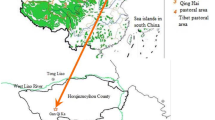Summary
A single layer (Penman-Monteith) and a two layer (modified Shuttleworth-Wallace) evapotranspiration (ET) model are used alternatively to derive conductances related to the dominant fluxes of water vapor from a semi-closed Scots pine plantation. The derivations are based on micrometeorological measurements of above canopy energy flux densities and a simple resistance network. For a period of consecutive fine weather days, below canopy net radiation and below canopy ET were about 20 percent of the corresponding above canopy values. Resulting conductances for latent heat flux agreed well with porometric measurements of pines and understory scaled to canopy level. The shift from single to two layer modelling reduced the canopy conductance to pine conductance by the fraction of understory ET.
However, characteristics of porometer results and micrometeorologically derived conductances were quite different: The porometer estimates of conductance were highly variable due to stomatal response to local environmental conditions or “natural” variability within the tree canopy and vegetation patches which characterized the forest understory. Micrometeorologically derived conductances integrate spatially resulting in relatively smooth and repetitive daily patterns that lack the information of small scale variability. This is seen as a favorable feature of micrometeorological derived conductances when used for the parameterization of atmospheric models for climate research as long as small scale bio-diversity is irrelevant.
Similar content being viewed by others
References
Avissar, R., 1993: Observations of leaf stomatal conductance at the canopy scale: an atmospheric modelling perspective.Bound-Layer Meteor. 64, 127–148.
Gay, L. W., Vogt, R., Bernhofer, Ch., Blanford, J. H., 1996a: Flux agreement above a Scots pine plantation.Theor. Appl. Climatol. 53, 33–48.
Gay, L. W., Vogt, R., Kessler, A., 1996b: The May–October energy budget of a Scots pine plantation at Hartheim, Germany,Theor. Appl. Climatol. 53, 79–94.
Granier, A., Biron, P., Köstner, B., Gay, L. W., Najjar, G., 1996: Comparison of xylem sap flow and water vapour flux at the stand level and derivation of canopy conductance for Scots pine.Theor. Appl. Climatol. 53, 115–122.
Jaeger, L., Kessler, A., 1996: The HartX period May 1992, seen against the background of twenty years of energy balance climatology at the Hartheim pine forest.Theor. Appl. Climatol. 53, 9–21.
Joss, U., Graber, W. K., 1996: Profiles and simulated exchange of H2O, O3, NO2 between the atmosphere and the Hartheim Scots pine plantation.Theor. Appl. Climatol. 53, 157–172.
Kelliher, F. M., Leuning, R., Raupach, M. R., Schulze, E.-D., 1995: Maximum conductances for evaporation for global vegetation types.Agric. Forest Meteor. 73, 1–16.
Koestner, B., Biron, P., Siegwolf, R., Granier, A., 1996: Estimates of water vapor flux and canopy conductance of Scots pine at the tree level utilizing different xylem sap flow methods.Theor. Appl. Climatol. 53, 105–113.
Lafleur, P. M., Rouse, W. R., 1990: Application of an energy combination model for evaporation from sparse crops.Agric. Forest Meteor. 49, 135–153.
McNaughton, K. G., van den Hurk, B. J. J. M., 1994: Revision of the two-layer resistance model for the energy balance of sparse canopies. 21st Conf. Agric. Forest Meteorol., March 7–12, 1994, San Diego, Preprint Volume, 92–93.
Shuttleworth, W. J., Wallace, J. S., 1985: Evaporation from sparse crops — An energy combination theory.Quart. J. Roy. Meteor. Soc. 111, 839–855.
Sinclair, T. R., Knoerr, K. R., 1982: Distribution of photosynthetically active radiation in the canopy of a loblolly pine plantation.J. Appl. Ecology 19, 183–191.
Stannard, D. I., 1993: Comparison of Penman-Monteith, Shuttleworth-Wallace, and modified Priestley-Taylor evapotranspiration models for wildland vegetation in semiarid rangeland.Water Resour. Res. 92, 1379–1392.
Stewart, J. B., 1988: Modelling surface conductance of pine forest.Agric. Forest Meteor. 43, 17–35.
Sturm, N., Reber, St., Kessler, A., Tenhunen, J. D., 1996: Soil moisture variation and plant water stress at the Hartheim Scots pine plantation.Theor. Appl. Climatol. 53, 123–133.
Tenhunen, J. D., Siegwolf, R. A., Oberbauer, S. F., 1994: Effects of phenology, physiology and gradients in community composition, structure, and microclimate on tundra ecosystem CO2 exchange. In: Schulze, E.-D., Caldwell, M. M. (eds)Ecophysiology of Photosynthesis, Ecol. Studies, Vol. 100. Berlin, Heidelberg, New York: Springer, pp. 433–460.
Thom, A. S., 1972: Momentum, mass, and heat exchange of vegetation.Quart. J. Roy. Meteor. Soc. 98, 124–134.
Thom, A. S., Oliver, H. R., 1977: On Penman's equation for estimating regional evapotranspiration.Quart. J. Roy. Meteor. Soc. 103, 345–357.
Vogt, R., Bernhofer, Ch., Gay, L. W., Jaeger, L., Parlow, E., 1996: The available energy above a Scots pine plantation: what's up for partitioning?Theor. Appl. Climatol. 53, 23–31.
Vogt, R., 1995: Theorie, Technik und Analyse der experimentellen Fluβbestimmung am Bespiel des Hartheimer Kiefernwaldes. Ein Beitrag zu den Energiebilanzuntersuchungen in REKLIP. Inauguraldisseration, Universität Basel (to be published as “stratus 3”), 108 pp.
Wallace, J. S., 1993: Recent developments in evaporation modelling. Proc. Symp. Precipitation and Evaporation (Eds.: Becker, A., Sevruk, B., Lapin M., 20–24 September 1993, Bratislava, Slovakia, Vol. 3, 43–54.
Wedler, M., Heindl, B., Hahn, S., Köstner, B., Bernhofer, Ch., Tenhunen, J. D., 1996: Model-based estimates of water loss from “patches” of the understory mosaic of the Hartheim Scots pine plantation.Theor. Appl. Climatol. 53, 135–144.
Author information
Authors and Affiliations
Additional information
With 5 Figures
Rights and permissions
About this article
Cite this article
Bernhofer, C., Blanford, J.H., Siegwolf, R. et al. Applying single and two layer canopy models to derive conductances of a Scots pine plantation from micrometeorological measurements. Theor Appl Climatol 53, 95–104 (1996). https://doi.org/10.1007/BF00866414
Received:
Revised:
Issue Date:
DOI: https://doi.org/10.1007/BF00866414




